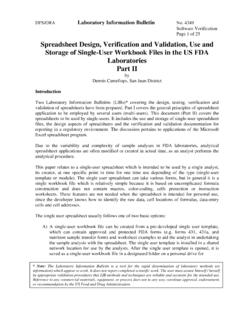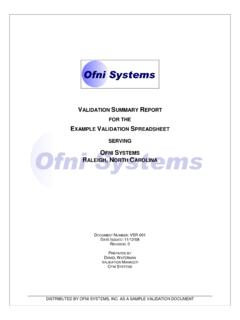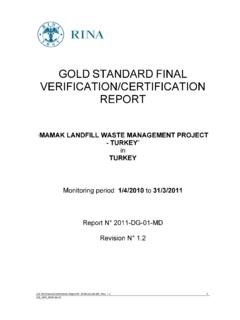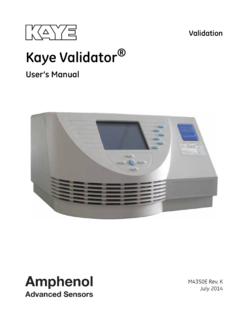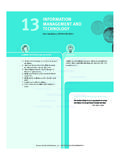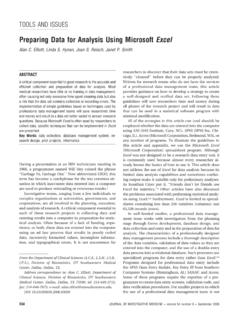Transcription of GAMP 5 ARiskA Risk-Based Approach toBased …
1 GAMP 5 ARiskBased Approach toA Risk-Based Approach toCompliant gxpcompliant GxP computerized SystemsStephen Shields10 September 2013 ASQOStiMtiPt1 ASQ Orange Section Meeting Part 1 Disclaimer This presentation is made at the request of ASQ. The presenter is a full-time employee and stockholder of Allergan, Inc. The information provided and opinions expressed during this presentationThe information provided and opinions expressed during this presentation are those of the presenter and are not the position of and may not be attributed to Allergan, Inc. 2 Agenda Overview Life Cycle Approach Life Cycle Phases Concept Project Software Category and Life Cycle Approach3 GAMP Document Structure4 Drivers for GAMP 55 Purpose computerized systems are fit for intended use Compliant with applicable regulations Good Manufacturing Practice (GMP) GdCliilP i (GCP) Good Clinical Practice (GCP) Good Laboratory Practice (GLP) Good Distribution Practice (GDP) Medical Device Regulations (excluding medical device software)
2 Provide framework which aims to safeguard patient safety, product quality, and data integrity, while also delivering business benefit Framework aims to safeguard patient safety, product quality, and data i tithilld liib ibfitintegrity, while also delivering business benefit6 Main Body Structure Life cycle Approach within a Quality Management system Life cycle phases: ConceptPj t Project Planning Specification, Configuration, and Coding Verification Reporting and Release Operation Retirement Science based quality risk managementqyg Regulated company activities: Governance for achieving compliance system specific activities Supplier activities Efficiency improvements7 Key Concepts8 computerized SystemPIC/S Good Practices for Computerised Systems in Regulated GXP Environments (PI 011)9 Typical computerized Systems Clinical Trials Data Management Manufacturing Resource Planning Laboratory Information Management Automated Manufacturing Equipment Automated Laboratory Equipment Process Control and Process Analysis Manufacturing Execution Building Management Warehousing and Distribution Blood Processing Management Adverse Event Reporting (vigilance)
3 Document Managementg Track and Trace10 Life Cycle ApproachASTM E2500-07 Standard Guide for Specification, Design, and Verification of Pharmaceutical and Biopharmaceutical Manufacturing Systems and Equipment,11 Life Cycle Phases12 Concept Phase Strategic Planning Need Identification Business Justification Compliance Justification Migration Need Technical Feasibility Management Commitment User Requirement Initiation Project Initiation13 Project Phase - Stages Planning Specification, Configuration, Coding Verification Reporting and ReleaseRReleaseSupporting ProcessesRisk Management Change & Configuration Management Design Reviews Document Control Traceability14 Operation Phase - Stages15 Planning Stage A clear and complete understanding of User Requirements is needed Planning should cover all required activities, responsibilities, procedures, and timelines Activities should be scaled according to.
4 system impact on patient safety, product quality, and data integrity (risk assessment) system complexity and novelty (architecture and categorization of system components)fli(libili ) outcome of supplier assessment (supplier capability) The Approach should be based on product and process understanding, and relevant regulatory requirements16 Specification, Configuration, and Coding Stage The role of specifications is to enable systems to be developed, verified, and maintained based on the user s requirements and risk profile Any required configuration should be performed in accordance with a tlld dtblcontrolled and repeatable process Any required software coding should be performed in accordance with defined standards. Configuration management is an intrinsic and vital aspect of controlled Configuration management is an intrinsic and vital aspect of controlled configuration and Stage Verification confirms that specifications have been met Verification activities occur throughout the project stages Design ReviewsTi Testing An appropriate test strategy should be developed based on the risk, complexity, and novelty.
5 Supplier documentation should be assessed and used if suitable Supplier documentation should be assessed and used if suitable. The test strategy should be reviewed and approved by appropriate SMEs Tests should cover hardware, software, configuration, and acceptance18 Reporting and Release Stage At the conclusion of the project, a computerized system validation report should be produced summarizing the activities performed, any deviations from the plan, any outstanding and corrective actions, and providing a statement of fitness for intended use of the systemstatement of fitness for intended use of the system . The system should be accepted for use in the operating environment and released into that environment in accordance with a controlled and documented process.
6 P Acceptance and release of the system for use in GxP regulated activities should require the approval of the process owner, system owner, and quality unit representatives. Well managed system handover from the project team to the process owner, system owner, and operational users is a pre-requisite for effectively maintaining compliance of the system during Processes Risk Management Change and Configuration Management Design Review Traceability Document Management20 Software Categories Category 1 Infrastructure Software Established or commercially available layered software Infrastructure software tools Category 3 NonConfigured Products Category 3 Non-Configured Products Commercial-Off-The-Shelf (COTS) system that cannot be configured to conform to business processes or are configurable but only the default configuration is used.
7 Category 4 Configured Products Products provide standard interfaces and functions that enable configuration of user specific business processes. Category 5 Custom Applications These systems or subsystems are developed to meet the specific needs of the regulatedThese systems or subsystems are developed to meet the specific needs of the regulated company21 Typical Life Cycle Approach Category 1 DescriptionTypical ExamplesTypical ApproachLayered SoftwareSoftware used to manage the operating Operating Systems Database Engines Middleware ProgrammingLanguagesRecord version number, verify correct installation by following approved installation proceduresmanage the operating environment ProgrammingLanguages Statistical Packages Spreadsheet Application Network Monitoring Toolsinstallation procedures Scheduling Tools Version Control Tools22 Typical Life Cycle Approach Category 3 DescriptionTypical ExamplesTypical ApproachRun-time parameters may be entered and stored, but the software cannot be configured to Firmware-base Apps COTS Software Instruments Abbreviated life cycle Approach .
8 URS. Risk-Based Approach tocannot be configured to suit the businessprocess. Risk-Based Approach to supplier assessment. Record version number, verify correct installation. Risk-Based tests against requirements as dictated by use. Procedures in place for Procedures in place for maintaining compliance and fitness for intended Life Cycle Approach Category 324 Typical Life Cycle Approach Category 4 DescriptionTypical ExamplesTypical ApproachSoftware, often very complex that can be LIMS Data acquisition Life cycle Approach . Risk-Based Approach to supplier complex, that can be configured by the user to meet the specific needs of the Data acquisitionsystems SCADA ERPppppassessment. Demonstrate supplier has adequate QMS Some life cycle documentation retained only by supplier (e g Design Spec)user s business code is not altered MRPII Clinical Trialmonitoring DCSonly by supplier ( , Design Spec) Record version number, verify correct installation.
9 Risk-Based testing to demonstrate application works as designed in a test altered. DCS ADR Reporting EDMS BMSenvironment Risk-Based testing to demonstrate application works as designed within the business process Procedures in place for maintaining CRM Spreadsheets Simple HMIs Procedures in place for maintaining compliance and fitness for intended use Procedures in place for managing data25 Typical Life Cycle Approach Category 426 Typical Life Cycle Approach Category 5 DescriptionTypical ExamplesTypical ApproachSoftware custom designed and codedVaries, but includes: Internally andSame as for configurable, plus: More rigorous supplierdesigned and coded to suit the business process. Internally and externally developed IT applications Internally and More rigorous supplier assessment, with possible supplier audit Possession of full life cycle externally developed process control applications Custom ladder logicdocumentation (FS, DS, structural testing, etc.)
10 Design and source code review Custom ladder logic Custom firmware Spreadsheets (macro)review27 Typical Life Cycle Approach Category 528 Questions?Stephen ShieldsWWQA DirectorWWQA DirectorComputerized system Compliance and QualityAllIAllergan.
